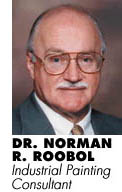Roobol on Painting


Powder Coatings as Gel-Coats
We are a manufacturer of custom fiberglass molders of epoxy and polyurethane parts of many sizes. Are there any studies being done on the possibility of using powder coating as a gel-coat on a mold before applying fiberglass backing?Yes, this has been done for some time now by spraying powder into heated molds. Subsequently, additional heat may be used to cure the powder more completely. The powder suppliers will be pleased to work with you on this application.
Battling Pinholes
I am interested in counteracting pinholes. I believe a powder clearcoat can cover a very large percentage of this type of defect. But I also believe that the pinholes harbor contamination from rinsing after being machined, even when preheated for clearcoat application.
1. Can this rinse contamination turn into a gas beneath the clearcoat and rise? If so, can we add a product to enhance evaporation?
2. Can raised pinholes be reduced through heat-treatment? Would the product harden more in the heat-treat process?
3. Can an additive in the powder clearcoat enhance flow?
This current problem affects many aluminum wheels; any input would be most helpful.
The answer to both parts of question 1 is no. You need to clean and rinse properly. In some cases, outgas problems are reduced by baking the parts prior to painting. Greater hardening will not help the situation. Some coating formulations show far less outgas pinholes and blisters than others, so work with your supplier on this.
Powder Coating Wood
Respected Sir, have you any knowledge regarding powder coating technology for wood?
I enjoyed the polite way you addressed me, thank you. The principle concern in powder coating wood is the moisture content of the substrate. Too much moisture will cause the coating to blister as water vapor is driven out of the wood during curing. While UV-curing greatly reduces the problem, it does not eliminate it. Be sure to read the article on pages 26-28 of the December 2001 issue on this subject. Powder suppliers will also be willing to help you determine if your substrate is amenable to being powder coated.
Coating Aluminum Extrusions
I am a manager of an electrostatic, vertical, liquid-painting operation using rotary discs and painting with high-solids polyesters. We used to have a horizontal powder coat line but discontinued it due to the lack of business at that time for the length of aluminum extrusions we were coating.
I have two questions.
1. We are seeing powder coated products being offered at cheaper prices than liquid painted products. How do powder coaters paint for less than liquid paint? Is it labor, better transfer efficiency or what?
2. Is a vertical line or a horizontal line better for high-volume production?
I am very interested in your answer, as it may affect the direction we take in the next five years.
Without knowing just what coating and how thick it is applied, I can't precisely answer the question as to why the powder coated extrusions can be sold for less than liquid painted ones. The coating cost should not be that different if polyester coatings are used in powder coating and liquid coating. Although both are applied electrostatically, certainly with recovery and reuse the transfer efficiency of powder will be much better than can be achieved with liquid paint. Labor for loading and unloading the parts should be about the same. Equipment and operating costs will also be quite similar. Also, remember that marketing strategies may lead to temporary cost variances.
In most cases, a vertical extrusion orientation is better for liquid coating using an omega booth with reciprocating electrostatic disc(s). It avoids multiple rack marks and is readily adaptable to coating any length piece that fits the booth silo. On the other hand, vertical powder coating of very long lengths (8 to 10 feet) is not at all convenient due to the equipment complications this would entail. If all your pieces are shorter than this, powder can be readily applied onto vertically hung parts. Depending on the part configurations, either an omega booth or a straight-line booth might be preferable.
Painting and Pregnancy
I am three months pregnant and I work with industrial paint. I wear a respirator. How safe is it?
Congratulations on your pregnancy! However, without knowing what exact type of respirator is worn or what chemicals the paint contains, it would be presumptuous of me to answer authoritatively. I'd suggest you consult your physician on this topic. Please err on the side of caution if any doubt exists about your health and safety and that of your baby.
Get the Book
I tried finding your book, Painting Problems: Solved, on Amazon.com without success, although you assured me they sold it.
Go to their Web site. In any search box, put in "Roobol" or "roobol" or "ROOBOL" and you will find it. It's $49.95 plus shipping.
More on Electrostatic Grounding
In answer to a question on electrostatic grounding, I don't feel that you went far enough. I was in electrostatics when we sprayed silver metallic paint onto electrical wiring devices. The pressure pot had to be put on an insulated stand to prevent the charge from feeding back through the paint in the hose itself, not only along any dried coating on the hose or spray gun. We also had to make sure that the voltage was off and the pot grounded during refilling.
Thanks for adding to my answer. Although the original question did not involve conductive coatings, what you listed is correct for conductive metallic or waterborne paints. Helpful comments such as this from readers are very much appreciated.
Looking for a reprint of this article?
From high-res PDFs to custom plaques, order your copy today!





